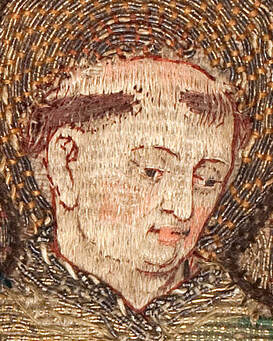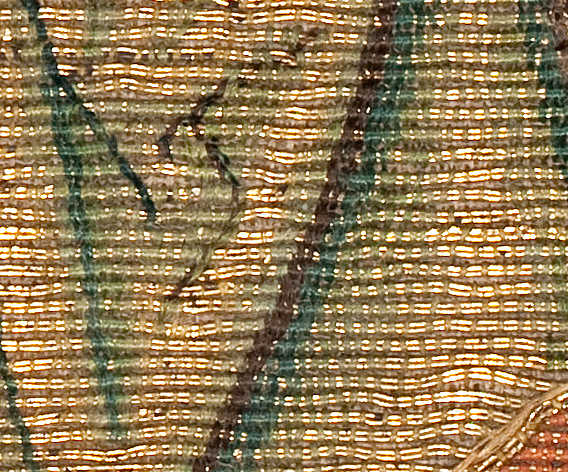|
Last week, Dr Katrin Kania, a fellow archaeologist and medieval textiles researcher, posted an intriguing article on her blog on gummy silk. In it, she mentioned a conversation she had had in the past with a conservator who had stated that medieval silk had a much firmer structure. This firmer structure probably has to do with the fact that this silk was only partly de-gummed (i.e. cleaned of silkworm spittle, the stuff that glues the silk threads together to form the cocoon). In contrast, the Chinese flat silk I like to use for my medieval embroideries is completely de-gummed. This results in a soft thread with a very high sheen. As I love silk and anything medieval, the combination of the two sounded like a real treat. In addition, questions on silk gum had also come up with my students. So, I ordered a spool of gummed silk from Katrin to see the stuff for myself. When it arrived, Katrin had kindly included some samples of the silk experiments she talked about in her blog. Time for me to test these in some simple stitching experiments! First things first. I started by taking macro-pictures of all the silk threads. When you compare the silk samples provided by Katrin with the Chinese flat silk, you'll see that Katrin's samples are all more twisted. Such threads are not ideal for for instance silk shading. With silk shading, you try to achieve a smooth surface for maximal sheen and optimal blending of colours. Additionally, the silks that still have gum in them are very stiff/stringy and don't feel like silk at all. When used in embroidery, they would not naturally 'spread' as embroidery silk does. This would create bumps when using in or nue. So, I don't think that gummed or partly de-gummed silk threads were used in the making of medieval orphreys. To illustrate this further, I have stitched a few samples. Here you see the four samples I have stitched using simple long-and-short stitch. From left to right: gummed silk, partly de-gummed silk, de-gummed silk and Chinese flat silk. Although very different in thickness, the de-gummed silk and the Chinese flat silk performed similarly. The thicker de-gummed silk from Katrin has just a little more twist than I would like. The two silks that still have gum on them were unsuitable for long-and-short stitch, just as I predicted. As the thread does not 'spread' it was difficult to cover the ground fabric completely. The surface looks very bumpy and unruly. I've also done some simple couching with a left-over piece of passing thread. Again, the de-gummed silk and the Chinese flat silk performed best. They produced uniform couching stitches. The silk with gum produced couching stitches of various thicknesses. How do my samples compare to the long-and-short stitched areas and the couching areas of medieval orphreys? Even though the silk on the face of St Lawrence has deteroriated somewhat, it compares best to the completely de-gummed silks. As various thicknesses of very fine silk threads were used, Chinese flat silk works best. As an embroiderer, you have total control over the thickness of your thread as you can split as you like. The same holds true for the or nue detail from St Lawrence. You can download a very high-resolution picture from the website of Museum Catharijneconvent so that you can zoom in even more. You will then also see that the couching stitches of the or nue lay flat and that there is a minimal twist. That's the same when you use Chinese flat silk. As long as you pay attention to your thread and let it 'dangle' every so often, you will have minimal twist too.
My conclusion is that the fine embroidery on medieval orphreys was made with fully de-gummed silk. Comparing my samples with the close-up pictures in the publication of the Imperial Vestments held at Bamberg also shows that they were made with un-twisted fully de-gummed silk. Literature Kohwagner-Nikolai, T., 2020. Kaisergewänder im Wandel - Goldgestickte Vergangenheitsinszenierung: Rekonstruktion der tausendjährigen Veränderungsgeschichte. Schnell + Steiner, Regensburg.
14 Comments
Darcy Walker
14/2/2022 16:33:37
Fascinating what comes up for discussion.
Reply
14/2/2022 20:50:27
Fascinating stuff! I always love seeing the examples that show not just how, but why things work.
Reply
15/2/2022 09:50:53
That's fascinating, Michael. Have you ever de-gummed a stiched piece?
Reply
Jo Wootton
14/2/2022 23:59:27
So interesting. Thank you Jessica.
Reply
15/2/2022 04:43:57
In doing the multiple years of research for my chronological development of Chinese Silk Embroidery book, I found no written text about using partially de-gummed silk in stitching. Now with my book updating research, I find this is an interesting text. Is it possible that our modern times and technology provide textile workers with an unique opportunity for this type of investigation? Or is the investigation prompted strictly by curiosity?
Reply
15/2/2022 09:52:47
That's very interesting, Elizabeth. I have a feeling that gummed silk and partly de-gummed silk were not used in normal surface embroidery in medieval Europe either.
Reply
Kathrine Richards
15/2/2022 12:20:40
I so enjoy reading your articles Jessica. You always lead me into unexpected further research. I'm now wondering if the 'gum' has any preserving or strengthening qualities for the silk after it has been stitched.
Reply
15/2/2022 14:19:08
It probably has as the thread is definitely much stronger. However, I don't know if the gum potentially atracts pests.
Reply
Your comment will be posted after it is approved.
Leave a Reply. |
Want to keep up with my embroidery adventures? Sign up for my weekly Newsletter to get notified of new blogs, courses and workshops!
Liked my blog? Please consider making a donation or becoming a Patron so that I can keep up the good work and my blog ad-free!
Categories
All
Archives
July 2024
|
Contact: info(at)jessicagrimm.com
Copyright Dr Jessica M. Grimm - Mandlweg 3, 82488 Ettal, Deutschland - +49(0)8822 2782219 (Monday, Tuesday, Friday & Saturday 9.00-17.00 CET)
Impressum - Legal Notice - Datenschutzerklärung - Privacy Policy - Webshop ABG - Widerrufsrecht - Disclaimer
Copyright Dr Jessica M. Grimm - Mandlweg 3, 82488 Ettal, Deutschland - +49(0)8822 2782219 (Monday, Tuesday, Friday & Saturday 9.00-17.00 CET)
Impressum - Legal Notice - Datenschutzerklärung - Privacy Policy - Webshop ABG - Widerrufsrecht - Disclaimer








 RSS Feed
RSS Feed